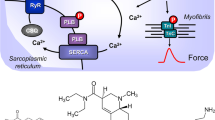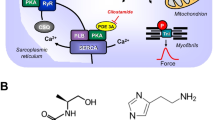Abstract
We have investigated the ability of 5-hydroxytryptamine (5-HT) to elicit arrhythmic contractions in isolated human atrial strips as a function of pacing rate (0.1–2 Hz) using a method recently introduced by us (Kaumann and Sanders, this journal, 1993b) and examined the nature of the 5-HT receptors involved. Right atrial appendage tissue was obtained from 14 patients undergoing cardiac surgery. None of the patients had advanced heart failure. 5-HT (0.6–20 μmol/l) induced arrhythmic contractions during pacing in 4/11 atrial strips from 3/4 patients who had not received β blockers and in 21/27 atrial strips from 9/10 patients who had been chronically treated with β blockers (primarily β1-selective). The incidence of arrhythmic contractions evoked by 5-HT did not reach statistical significance in the atrial tissue from the non-β blocked patients but was highly significant in the atrial tissue from the chronically β blocked patients. The arrhythmic contractions usually occurred more frequently at low than at high pacing rates and were observed at the physiological frequency of 1 Hz in 1/4 atrial strips from 1/4 of the non-β blocked patients and 6/11 strips from 5/10 of the β blocked patients. The 5-HT-evoked arrhythmic contractions were observed during blockade of β1-adrenoceptors, β2-adrenoceptors and 5-HT3 receptors, ruling out the participation of these receptors. The 5-HT-evoked arrhythmic contractions were totally inhibited within 30 min by the selective 5-HT4 receptor antagonist SB 203186 ((1-piperidinyl)ethyl 1H-indole 3-carboxylate) 100 nmol/l whereas they persisted in time-matched controls. The blockade of 5-HT-evoked arrhythmic contractions by SB 203186 was surmounted by high concentrations (400–1800 μmol/l) of 5-HT. Our results demonstrate that 5-HT elicits rate-dependent arrhythmic contractions in isolated human atrium through the 5-HT4 receptor and that they are facilitated in atrial tissue from patients treated with β blockers. Our results suggest that endogenous, platelet-derived 5-HT may cause atrial arrhythmias and that exogenous 5-HT4 agonists/partial agonists may be arrhythmogenic.
Similar content being viewed by others
References
Ansanay H, Sebben M, Bockaert J, Dumuis A (1992) Characterization of homologous 5-hydroxytryptamine4 receptor desensitization in colliculi neurones. Mol Pharmacol 42:808–816
Bateman DN (1986) The action of cisapride on gastric emptying and the pharmacodynamics and pharmacokinetics of oral diazepam. Eur J Clin Pharmacol 30:205–208
Berlin JR, Cannel MB, Lederer WS (1989) Cellular origin of the transient inward current in cardiac myocytes. Role of fluctuations and waves of elevated intracellular calcium. Circ Res 65:115–126
Bockaert J, Fozard JR, Dumuis A, Clarke DE (1992) The 5-HT4 receptor: a place in the sun. Trends Pharmacol Sci 13:141–145
Dumuis A, Sebben M, Bockaert J (1989) The gastrointestinal prokinetic benzamide derivatives are agonists at the non-classical 5-HT receptor (5-HT4) positively coupled to adenylate cyclase. Naunyn Schmiedebergs Arch Pharmacol 340:403–410
Fozard JR (1989) The development and early clinical evaluation of selective 5-HT3 receptor antagonists. In: Fozard J (ed) The peripheral actions of 5-hydroxytryptamine. Oxford University Press, Oxford, pp 354–376
Hall JA, Kaumann AJ, Brown MJ (1990) Selective β1-adrenoceptor blockade enhances positive inotropic responses to endogenous catecholamines mediated through β2-adrenoceptors in human atrial myocardium. Circ Res 66:1610–1623
Jahnel U, Rupp J, Ertl R, Nawrath H (1992) Positive inotropic responses to 5-HT in human atrial but not in ventricular heart muscle. Naunyn Schmiedebergs Arch Pharmacol 346:482–485
January CT, Fozzard HA (1988) Delayed afterdepolarizations in heart muscle: mechanisms and relevance. Pharmacol Rev 40:219–227
Kaumann AJ (1991a) Use of 5-HT4 receptor antagonists in the treatment of arrhythmias and stroke. International Patent Classification, A61K 31/00, 31/46
Kaumann AJ (1991b) 5-Hydroxytryptamine and the human heart. In: Fozard J, Saxena PR (eds) Serotonin: Molecular biology, receptors and functional effects. Birkhäuser, Basel, Switzerland, pp 365–373
Kaumann AJ, Lemoine H (1987) β2-Adrenoceptor-mediated positive inotropic effect of adrenaline in human ventricular myocardium. Quantitative discrepancies with binding and adenylate cyclase stimulation. Naunyn Schmiedebergs Arch Pharmacol 335:403–411
Kaumann AJ, Sanders L (1993a) 5-Hydroxytryptamine causes arrhythmias in isolated human atrium. Br J Pharmacol 108:245P
Kaumann AJ, Sanders L (1993b) Both β1- and β2-adrenoceptors mediate catecholamine-evoked arrhythmias in isolated human right atrium. Naunyn Schmiedebergs Arch Pharmacol 348:536–540
Kaumann AJ, Sanders L (1993c) 5-Hydroxytryptamine (5-HT) evokes beat rate-dependent arrhythmias in isolated human atrium. J Mol Cell Cardiol 25(Suppl 1):S 78
Kaumann AJ, Sanders L (1993d) 5-HT4 receptor-mediated arrhythmias in isolated human atrium. Meeting of the British and Italian Pharmacological Societies, Rome, September 1993
Kaumann AJ, Sanders L, Brown AM, Murray KJ, Brown MJ (1990a) A 5-hydroxytryptamine receptor in human atrium. Br J Pharmacol 100:879–885
Kaumann AJ, Sanders L, Brown MJ (1990b) Chronic β1-adrenoceptor blockade enhances positive inotropic responses to 5-hydroxytryptamine in human atrium. J Mol Cell Cardiol 22(Suppl III):S 2
Kaumann AJ, Sanders L, Brown AM, Murray KJ, Brown MJ (1991) A 5-HT4-like receptor in human right atrium. Naunyn Schmiedebergs Arch Pharmacol 344:150–159
Le Messurier DH, Schwartz CJ, Whelan RE (1959) Cardiovascular effects of intravenous infusions of 5-hydroxytryptamine in man. Br J Pharmacol 14:246–250
Olssen S, Edwards IR (1992) Tachycardia during cisapride treatment. Br Med J 305:748–749
Ouadid H, Seguin J, Dumuis A, Bockaert J, Nargeot J (1991) Serotonin increases calcium current in human atrial myocytes via the newly described 5-hydroxytryptamine4 receptors. Mol Pharmacol 41: 346–351
Parker SG, Hamburger S, Taylor EM, Kaumann AJ (1993) SB 203186, a potent 5-HT4 receptor antagonist, in porcine sinoatrial node and human and porcine atrium. Br J Pharmacol 108:68P
Sanders L, Kaumarm AJ (1992) A 5-HT4-like receptor in human left atrium. Naunyn Schmiedebergs Arch Pharmacol 345:382–386
Siegel S (1956) Nonparametric statistics for the behavioral sciences. McGraw Hill, New York, pp 95–110
Thandroyen FT, Morris AC, Hagler HK, Ziman B, Pai L, Willerson JT, Buja LM (1991) Intracellular calcium transients and arrhythmia in isolated heart cells. Circ Res 69:810–819
Vassalle M (1977) The relationship among cardiac pacemakers. Overdrive suppression. Circ Res 41:269–277
Wit AL, Rosen MR (1986) Afterdepolarizations and triggered activity. In: Fozzard HA (ed) The heart and cardiovascular system. Raven Press, New York, pp 1449–1490
Author information
Authors and Affiliations
Additional information
Correspondence to: A. J. Kaumann at the above address
Rights and permissions
About this article
Cite this article
Kaumann, A.J., Sanders, L. 5-Hydroxytryptamine causes rate-dependent arrhythmias through 5-HT4 receptors in human atrium: facilitation by chronic β-adrenoceptor blockade. Naunyn-Schmiedeberg’s Arch Pharmacol 349, 331–337 (1994). https://doi.org/10.1007/BF00170877
Received:
Accepted:
Published:
Issue Date:
DOI: https://doi.org/10.1007/BF00170877




